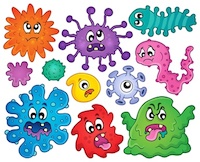 Not to put too fine a point on it, but there’s one item in your kitchen that has probably harbouring more germs than your toilet and rubbish bin combined; Your kitchen sponge. It is exposed to all manner of germs (raw chicken, the crumbs that fell on the floor after the dog walked in, cleaning out questionable items left too long in the fridge) and is most often damp and wet, making it a breeding ground for bacteria.
Not to put too fine a point on it, but there’s one item in your kitchen that has probably harbouring more germs than your toilet and rubbish bin combined; Your kitchen sponge. It is exposed to all manner of germs (raw chicken, the crumbs that fell on the floor after the dog walked in, cleaning out questionable items left too long in the fridge) and is most often damp and wet, making it a breeding ground for bacteria.
Bacteria can grow at an alaming rate; some can double every 20 minutes!
Sponges are porous, meaning there is plenty of opportunities for pieces of food or dirt to become lodged in them.
To prevent sponges spreading germs, rather than actually cleaning them up, they need to be hygienically cleaned, dried and replaced regularly (daily cleaning and weekly replacement).
Many kitchens have a variety of chopping boards to prevent cross contamination between meat, fruit etc. Ideally, keep one sponge for the bench and food spills, another for heavier duty cleaning and the floor.
If you’re not sure about how clean your sponge is, give it the sniff test – if it smells foul, it will be teeming with little nasties.
To sterilise your sponge, there are two fast and easy methods. Firstly, combine bleach and boiling water and let it soak for a few minutes (squeezing regularly), then let it dry completely. (This is a good habit to get into at night, so that each morning your sponge is dry and sterile). Secondly, if you prefer not to use bleach, place your sponge in a bowl of water in the microwave and heat until the water is bubbling. Again, squeeze and dry completely.









T0NYC0 - 9 years ago
surely it is best to buy a pack of dish cloths and wash them each day as you do the laundry? Hanging them in the sun kills most nasties. They are cheap too, at the supermarket. Those spongy scouring pads are an illness waiting to happen!
Put everything you can in the dishwasher or use a dish brush, these don’t hold the germs so easily, even the brush can go in the dishwasher.